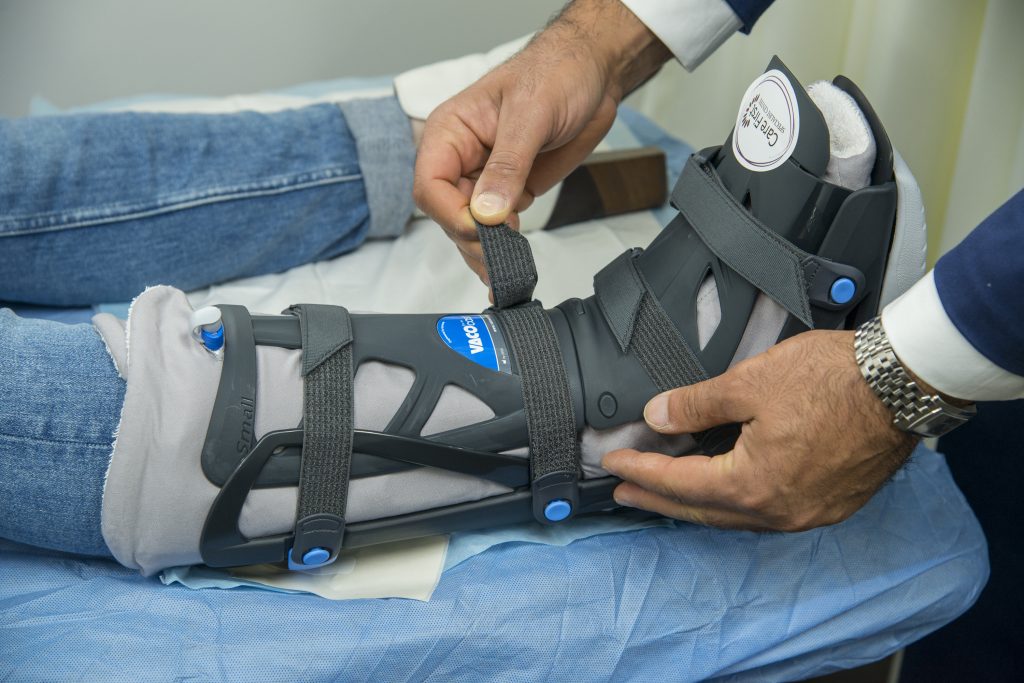Flatfoot Treatments
What is an Adult Acquired Flatfoot Deformity?
Adult Flatfoot Deformity is a condition of the foot where the arch on the inside of the foot collapses to the ground after previously being normal. This is also known as “fallen arches” or medically as Pes (Foot) Planus (Flat).
What happens if Adult Acquired Flatfoot Deformity is left untreated?
Unfortunately, Adult Acquired Flatfoot Deformity is progressive and generally gets worse with time. As the deformity progresses arthritis and stiffness will develop in the many joints of the foot and ankle. Early recognition, diagnosis, and treatment is essential to prevent the progression and allows patients to remain active and pain free.
What are the non-operative treatments for Flatfoot?
Patients with early evidence of posterior tibial tendon insufficiency leading to adult acquired flatfoot deformity and minimal pain are encouraged to attempt non-surgical treatments. This usually involves activity modification, orthotic arch supports, physical therapy to
encourage stretching and muscle rebalancing and anti-inflammatory medications.
Book an Appointment Today!
What are the surgical treatments for Flatfoot?
Surgery is offered to patients with persistent pain and symptoms despite all attempts at non-operative treatments. The goal of surgery is to correct the deformity by restoring the bony alignment and balancing the soft tissues of the foot and ankle. This will relieve the associated pain and prevent progression or re-occurrence.
Every flatfoot is different, and a detailed pre-operative assessment by Dr. Chow will ensure the appropriate operation can be tailored to the individual patient. Dr. Chow has extensive experience locally and internally on the various procedures that are required to address these factors and will offer you the best procedure to fit the needs of your foot.
Flatfoot Surgery may involve:
- Realignment of multiple bone of the foot and ankle.
- Fusions (Joining of affected bones) of the foot and ankle.
- Tendon transfers and reconstructions.
- Soft tissue balancing.
- Bone grafting.


What to expect after Flatfoot surgery
You should expect to stay 3-4 days in hospital with your leg elevated. This will allow for adequate pain control and a thorough physiotherapy assessment. You will be placed in a post-operative boot and advised not to weight bear on the foot. Depending on the operation performed on your foot the weight bearing status will vary along with the duration of blood thinners required to prevent clots.
Dressings are to remain dry and intact until your first post-operative appointment. Your sutures will be removed after 2 weeks and scar massage, desensitization and early ROM will commence with a physiotherapist. A repeat x-ray will be undertaken at 6 weeks, however expect to be in the boot for at least 12 weeks.
At 3 months the boot will be removed and transition into normal shoes along with physiotherapy for strengthening, range of motion and balance retraining. The ongoing recovery usually lasts for up to 6-9 months.
Potential complications of Flatfoot surgery
All surgical procedures involve inherent risk of complications. However, these risks are generally uncommon and quite infrequent. These include anesthetic complications, wound infections, nerve injuries, tendon injuries, bleeding, fracture, failure of bone to heal, ongoing pain, stiffness, chronic regional pain syndrome, blood clots, recurrence of the deformity and development of arthritis.
Patients can minimize the risk of complications by carefully following post-operative instructions.
